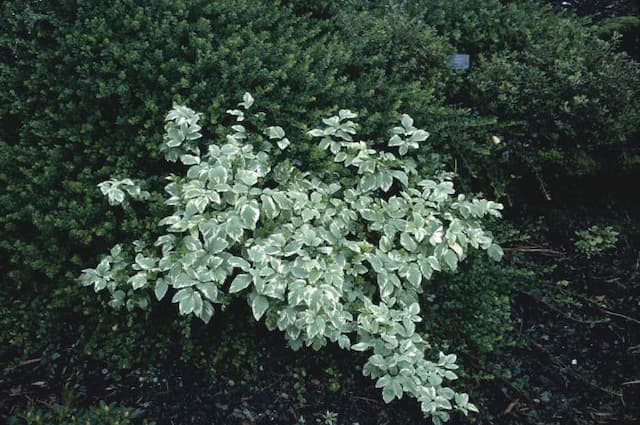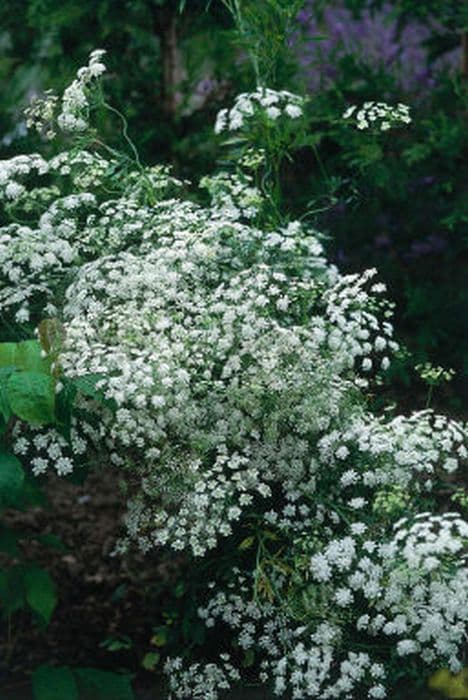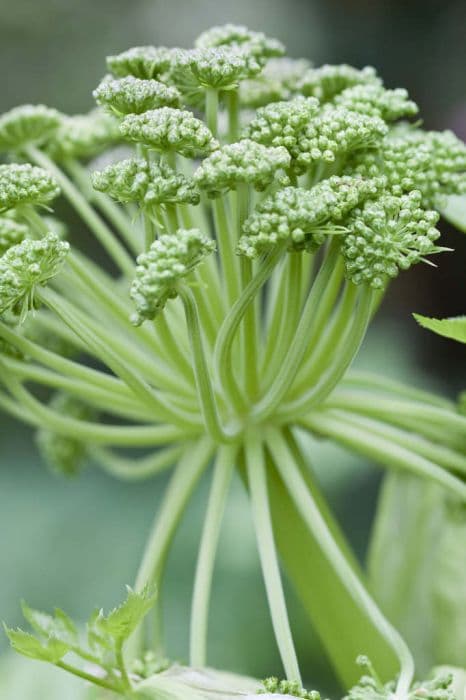Green Dream Mathiasella bupleuroides

ABOUT
The plant known as Green spire, is an ornamental perennial with a distinctive appearance. It boasts lush foliage that is bluish-green in color, with leaves that have a slightly rough texture and are shaped like those of the common geranium - rounded with a scalloped edge. Throughout the spring and early summer months, the Green spire produces unique flower structures. The inflorescences emerge as clusters encased in papery bracts that initially appear in shades of green and later mature to a purple or pinkish hue. These intriguing bracts add to its decorative appeal and ensure that it catches the eye in any garden setting. The flowers within are small and bell-shaped, complementing the bracts with a delicate contrast. Overall, the Green spire's striking foliage and distinctive flowers make it a favorite among garden enthusiasts for providing visual interest and a touch of elegance.
About this plant
 Names
NamesFamily
Apiaceae
Synonyms
Green Dream, Mathiasella
Common names
Mathiasella bupleuroides
 Toxicity
ToxicityTo humans
Mathiasella bupleuroides, commonly known as Greenbell, does not have a well-documented profile of toxicity to humans. There is limited information available regarding its ingestion and possible side effects. However, many plants are potentially toxic, and it is generally advised to avoid ingesting parts of plants that are not known to be safe or are not intended for consumption. Without specific toxicological data, the symptoms of poisoning are also not documented. It is wise to err on the side of caution and not consume any part of the Greenbell plant.
To pets
Greenbell (Mathiasella bupleuroides) is not well-known for its toxicity profile in pets such as dogs and cats. There is insufficient data on the effects of ingestion by animals, and as a result, specific symptoms of poisoning are not well-documented. Like with humans, pets should not ingest plants or plant materials that are not known to be safe or specifically meant for animal consumption. Owners should supervise their pets to prevent the ingestion of any parts of Greenbell due to the lack of information on its potential toxicity.
 Characteristics
CharacteristicsLife cycle
Perennials
Foliage type
Deciduous
Color of leaves
Green
Flower color
Greenish-blue
Height
3-4 feet (0.91-1.22 meters)
Spread
2-3 feet (0.61-0.91 meters)
Plant type
Shrub
Hardiness zones
7
Native area
Mexico
Benefits
 General Benefits
General Benefits- Aesthetic Appeal: Mathiasella bupleuroides, commonly known as 'Green Dream', is prized for its unique blue-green bracts and nodding, bell-shaped flowers that add color and visual interest to gardens.
- Low Maintenance: Once established, 'Green Dream' is a low maintenance plant, requiring minimal care in terms of watering and fertilization.
- Attracts Pollinators: The flowers of 'Green Dream' attract a variety of pollinators, including bees and butterflies, which are beneficial for garden pollination and local ecosystems.
- Long Blooming Season: Offering a relatively long blooming season from late spring to early summer 'Green Dream' provides a lengthy period of visual enjoyment.
- Versatile Garden Use: 'Green Dream' can be used in various garden settings, including borders, as part of mixed perennial plantings, or in cottage gardens, due to its medium height and structural blooms.
- Drought Tolerant: Once established, it exhibits good drought tolerance, making it suitable for gardens in drier climates or for gardeners seeking water-wise plants.
- Cold Hardy: 'Green Dream' is cold hardy and can survive in cooler temperatures, making it accessible to gardeners in varying climates.
 Medical Properties
Medical PropertiesThis plant is not used for medical purposes.
 Air-purifying Qualities
Air-purifying QualitiesThis plant is not specifically known for air purifying qualities.
 Other Uses
Other Uses- Mathiasella bupleuroides, commonly known as Green Envy, can be dried and used in floral arrangements, providing a unique, sculptural form and a long-lasting green hue to bouquets.
- The plant's sturdy stems and geometric flower structures make it an excellent choice for botanical art projects, such as botanical prints or eco-dyeing textiles.
- Green Envy can be utilized as an educational tool in botany and horticulture courses to demonstrate the unique characteristics of the Apiaceae family.
- Its attractive foliage and flowers serve as an inspiration for artists and designers, influencing patterns and motifs in textiles and wallpaper designs.
- The plant can be a natural pest deterrent in gardens due to its unique chemical makeup that certain pests find unappealing.
- Landscape architects use Green Envy as a focal point in garden design due to its unusual flowers and long-lasting visual interest.
- The aesthetic qualities of Mathiasella bupleuroides can be photographed and used for stock imagery in gardening magazines and websites.
- During the festive season, branches of Green Envy can be incorporated into wreaths and holiday decorations for a non-traditional, yet elegant touch.
- Garden enthusiasts use the plant to create 'living sculptures' by training and pruning it into distinctive shapes, appealing to modern garden sensibilities.
- It can be used in permaculture designs as part of a planting guild, supporting beneficial insects and adding to the biodiversity of the ecosystem.
Interesting Facts
 Feng Shui
Feng ShuiThe plant Mathiasella bupleuroides, commonly known as Green Envy, is not used in Feng Shui practice.
 Zodiac Sign Compitability
Zodiac Sign CompitabilityThe plant Green Envy is not used in astrology practice.
 Plant Symbolism
Plant Symbolism- Rarity: As a relatively uncommon plant in the gardening world, Mathiasella bupleuroides, commonly known as Green Envy, symbolizes the unique and the rare. It stands out in a garden much like a rare individual stands out in a crowd.
- Resilience: Green Envy is known for its hardiness and ability to thrive in various conditions, symbolizing resilience and the ability to endure challenging situations.
- Elegance: With its delicate greenish-blue flowers, Green Envy is often associated with elegance and grace. It represents the beauty that can be found in simplicity and subtlety.
- Harmony with Nature: Because of its green flowers, which blend seamlessly into foliage, this plant symbolizes harmony with nature and the environment, signifying a peaceful coexistence with the surrounding natural world.
 Water
WaterThe Green Hellebore should be watered regularly during its first growing season to establish a deep, extensive root system. Once established, it's more drought tolerant and will require less frequent watering. Provide a thorough soaking once a week, ensuring that the soil is moist but not waterlogged. During the hotter months, check the topsoil and if it's dry, water the plant with approximately 1 to 1.5 gallons, depending on the size and the environmental conditions. Reduce the frequency of watering during the winter season when the plant is dormant.
 Light
LightFor the Green Hellebore, the best lighting condition is dappled sunlight or partial shade. It thrives under the canopy of open trees or on the east or north side of buildings where it will receive morning light and afternoon shade. Avoid exposing it to the harsh afternoon sun as this can stress the plant and cause leaf scorch.
 Temperature
TemperatureThe Green Hellebore prefers temperatures ranging from 50 to 75 degrees Fahrenheit but can survive minimum temperatures down to around 20 degrees Fahrenheit. It is a hardy plant that can tolerate cold but should be protected from extreme heat above 80 degrees Fahrenheit. The ideal temperature for optimal growth falls within the cooler range of its tolerance, avoiding the stress of temperature extremes.
 Pruning
PruningThe Green Hellebore should be pruned to remove dead or damaged leaves and to maintain its shape. Prune in late winter or early spring before new growth begins. This is also the time to remove any old foliage from the previous year to make room for fresh growth. Pruning the Green Hellebore annually will encourage healthy growth and flowering.
 Cleaning
CleaningAs needed
 Soil
SoilGreen hellebore prefers well-draining soil rich in organic matter with a soil pH of around 6.0 to 7.0. A mixture of loam, peat, and sharp sand works well to create the right texture and fertility for this plant.
 Repotting
RepottingGreen hellebore is typically not repotted often as it is hardy and prefers to be left undisturbed. It may only need repotting every 4-5 years, and even then, only if it has outgrown its current container.
 Humidity & Misting
Humidity & MistingGreen hellebore thrives in average humidity levels and does not require any special humidity conditions. It is quite adaptable to the typical humidity found in its outdoor environment.
 Suitable locations
Suitable locationsIndoor
Place in bright indirect light, keep soil moist
Outdoor
Plant in partial shade, shelter from harsh elements
Hardiness zone
7-10 USDA
 Life cycle
Life cycleMathiasella bupleuroides, commonly known as Mathiasella, starts its life as a seed that germinates in spring when the conditions are moist and warm. The seedling develops into a rosette of leaves in its first year, establishing a strong root system. In subsequent years, it produces tall flowering stems in late spring or early summer, bearing unique greenish-blue flowers surrounded by bracts. Following pollination by insects, the plant sets seed that can be collected in late summer or fall once the seed heads dry out. The plant is perennial and will continue to grow and produce new foliage and flowers each year while it remains healthy and in favourable conditions. In the colder months, the plant dies back to the ground, entering a period of dormancy before restarting its cycle again in spring.
 Propogation
PropogationPropogation time
Spring-Early Summer
Propogation: Mathiasella bupleuroides, commonly known as green chile plant, is usually propagated by division. The best time to divide green chile plants is in the spring when new growth is starting to emerge. To propagate by division, carefully lift the entire plant from the ground using a garden fork, ensuring as much of the root system is intact as possible. Gently separate the clumps into smaller segments, making sure each new section has several growth points or shoots along with a healthy portion of roots. The divisions should be replanted quickly into well-prepared soil at the same depth they were growing before and watered well to help establish them. This method is most effective because it helps maintain the specific characteristics of the parent plant while encouraging healthy, vigorous new specimens.









